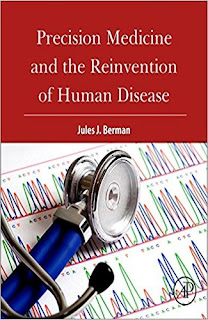Devoted to the topic of data specification (including data organization, data description, data retrieval and data sharing) in the life sciences and in medicine.
Thursday, February 8, 2018
RELIC DNA IN THE HUMAN GENOME
Yesterday's post listed 7 assertions regarding the role of infectious organisms on the human genome. In the next few blogs we'll look at each assertion, in excerpts from Precision Medicine and the Reinvention of Human Disease. Here's the first:
A significant portion of the human genome consists of relic DNA derived from ancient
invasive organisms.
About 8% of our genome is derived
from sequences with similarity to known infectious retroviruses, and these longer sequences
can usually be recognized by their contained subsequences (e.g., gag, pol, and env
genes) and long terminal repeats. The viral sequences in our genomes are the remnants of
ancient retroviral infections, and the occasional nonretroviral infection, that were branded
into DNA, and subsequently amplified [21–23]. Because much of the endogenous retroviral
load in the human genome is due to amplification, and subsequent mutation, it is hard to determine
the number of retroviral species that established their niche in the human gene pool,
but studies of these viral remains would suggest that we contain species from several dozen
families of retroviruses, with an undetermined number of contributions from individual family
members [24]. Based on comparisons of the viruses present in different species of primates,
it would appear that the most recent acquisition of an endogenous retrovirus occurred in
humans between 100,000 and 1 million years ago [25]. Most of the retroviral sequences in
our genomes are inactivated due to an accumulation of degenerative mutations collected over
the eons, indicating that there has been little or no selective pressure to conserve retroviruses
in their pristine sequences.
- Jules Berman
key words: precision medicine, human genome, evolution, infectious diseases, jules j berman, Ph.D., M.D.
Subscribe to:
Post Comments (Atom)


No comments:
Post a Comment